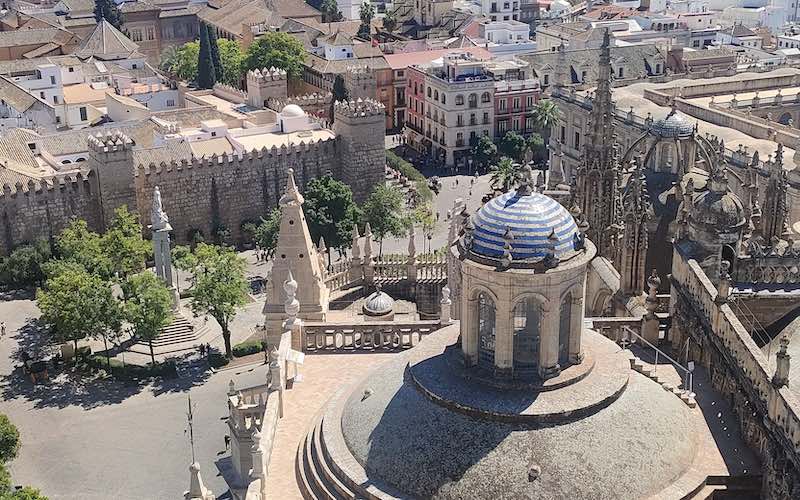Santa Cruz, located in the heart of Seville, is a historic neighborhood with a charm that is hard to resist. This enchanting barrio is a labyrinth of narrow streets, charming plazas, and traditional Andalusian architecture. The neighborhood was once the Jewish quarter of Seville and is now a popular destination for tourists and locals alike. From the colorful flower-filled balconies to the bustling tapas bars, Santa Cruz is a neighborhood that offers a true taste of Seville’s culture and history. So join me on a journey through the cobblestone streets and vibrant alleys of Santa Cruz, and discover the secrets of this magical corner of Seville.
When to explore the Santa Cruz Quarter of Seville
If you intend to go in the convent and museums and also add in a Flamenco show then you could easily spend a whole day enjoying Santa Cruz.
However, if you are short on time, I would highly recommend that you visit Santa Cruz in the evening. It is the best time to visit when the weather is milder and the people are filling the tapas bars and having a good time. If you take an evening from say 7-10pm that will be more than enough time. There may be some museums that you decide to come back and visit during the daytime (such as Hospital Los Venerables).
An overall recommendation is to avoid Seville in the summer months. I was sweltering in April – yes April!!! I don’t know how anyone can go in July or August when the temperatures soar to a massive 40 degrees – it’s not known as the ‘frying pan’ of Europe for nothing! Do yourself a favour – visit in the shoulder seasons (April/May or September/October) and explore early in the morning and again in the evening to avoid sunstroke.
Santa Cruz Guided tour or self guided walk?
I have mentioned that it is totally possible to do a walking tour of Santa Cruz on your own and without a guide, which is what I did. It’s a safe place to walk around as a solo female traveller and it’s a good idea to just explore with Google maps and this blog.
However, if you want more detail on the history of the area and a few inside recommendations, then you may want to join a guided tour. I recommend this guided tour of the Seville Jewish Quarter with Get Your Guide.
Start your Night off with some good Tapas
I started my evening with tapas at Restaurante Mateos near the Cathedral. The price was good (between €5-10 per tapas and you probably only need 2!) and the location was great for starting to explore Santa Cruz.
From there, once you have had your fill, head on a walk through the arch towards Patio de Banderas. You will walk through some beautiful cobbled streets, medieval arches and tiled squares. I have mapped out the best walking route of the Santa Cruz Quarter in Seville for you….
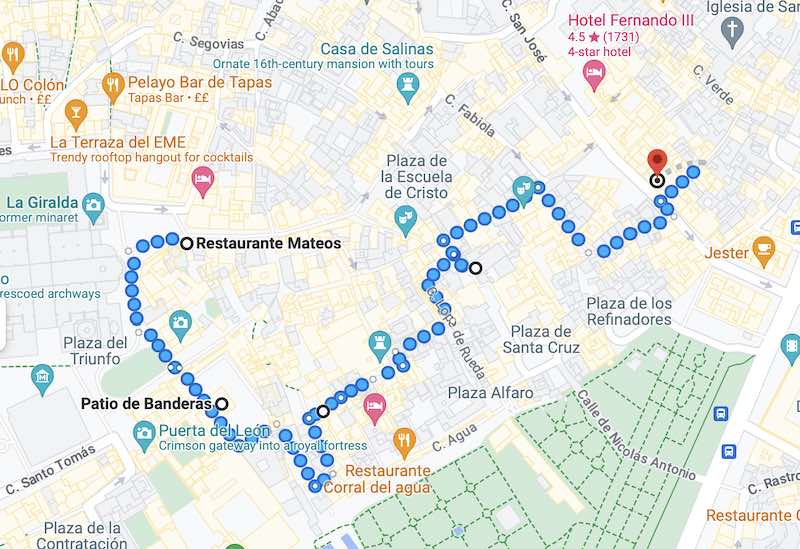
What to see and do in the Jewish Quarter of Seville
There is plenty to see and do in the Jewish Quarter of Seville. As well as these main attractions, it is generally a great place to eat, drink and be merry! Make sure that you see or experience the following….
- Seville Cathedral
- Puerto del Leon
- Patio de Banderas
- Walk through medieval arches and narrow streets to La Juderia
- Relax at the beautiful Plaza Doña Elvira
- Baroque Architecture of Hospital Los Venerables
- Convento de San José
- Iglesia de Santa Maria
- A Spanish Flamenco show
- The amazing tapas restaurants and wine bars scattered throughout the Santa Cruz district
Seville Cathedral
Visiting Seville Cathedral is an event within itself – allow at least one hour for this, possibly two if you would like to climb the Giralda and explore all of the side chapels. It is the largest Gothic cathedral and the third-largest church in the world, after St. Peter’s Basilica in Rome and the Basilica of the National Shrine of Our Lady of Aparecida in Brazil.
The cathedral was built on the site of a former mosque in the 15th century, after the Reconquista of Seville by Ferdinand III of Castile in 1248. Construction began in 1401 and continued for over a century, with different architects and builders contributing to the cathedral’s unique style.
The cathedral’s most iconic feature is its Giralda tower, which was originally built as a minaret during the Moorish occupation of Spain. The tower stands at 104 meters tall and has become a symbol of Seville. I dare you to climb the 35 floors to experience the phenomenal views from the top – I did! You will be pleased to know that there are slopes rather than stairs, this is because the Muezzin used to have to climb 5 times a day when this was the Minaret of a Mosque. This does make it slightly more manageable, but you need to be relatively fit to climb!
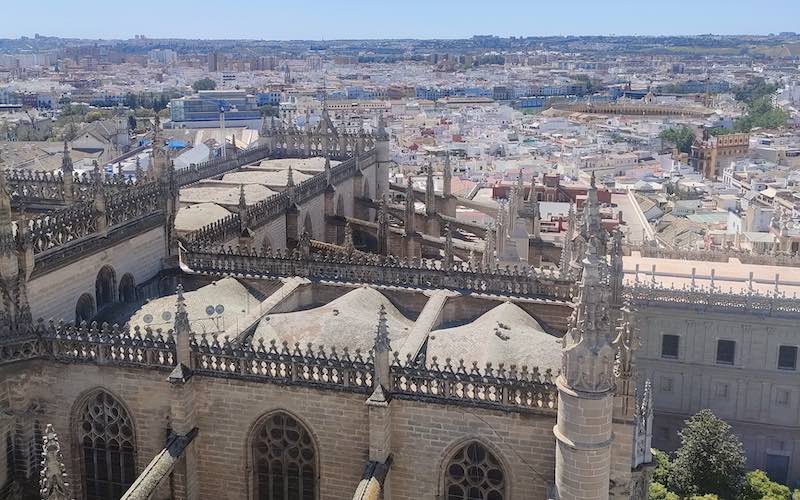
Inside the cathedral, visitors can see a number of stunning artworks and architectural features. Some of the highlights include the Retablo Mayor, a large altarpiece that depicts scenes from the life of Christ, and the Tomb of Christopher Columbus, which is believed to hold the remains of the famous explorer. Note that not ALL of Christopher Colombus’ body is contained in that tomb….they estimate it could be around 20%, and they don’t know which bit!
The cathedral also contains a number of chapels and a beautiful choir area, as well as a museum that displays artefacts and treasures from the cathedral’s long history. I would recommend that you spend a separate 3 hour tour for the Cathedral and Royal Alcazar.
Patio de Banderas
The name “Patio de Banderas” translates to “Courtyard of Flags” in English, and it is believed that this name refers to the flags of the countries that have visited Seville over the years.
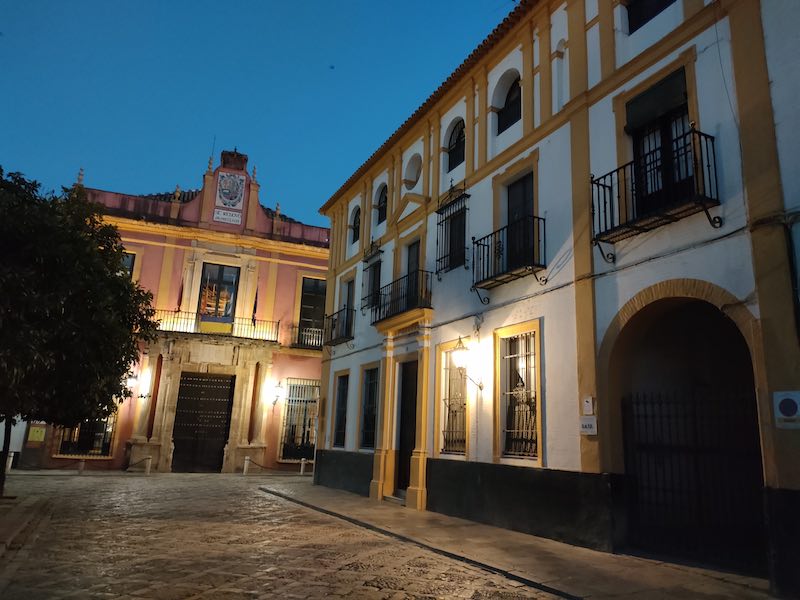
The square is located in the heart of the city, next to the Alcazar of Seville and the Cathedral of Seville, both of which are UNESCO World Heritage sites. The Patio de Banderas is also known for its beautiful views of the Giralda Tower, which is the bell tower of the Cathedral.
In addition to its historic and cultural significance, the Patio de Banderas is also a popular spot for tourists and locals alike to relax and enjoy the scenery. The square is surrounded by trees and benches, making it a great place to sit and people watch.
From this square, head out through the corner of the patio and follow a series of medieval arches through to Plaza Doña Elvira.
Plaza Doña Elvira
Plaza Doña Elvira is a beautiful and historic square located in the heart of Seville. The square is named after Doña Elvira, a legendary figure who is said to have lived in the area during the Middle Ages.
The Plaza Doña Elvira is known for its picturesque beauty and is surrounded by traditional Sevillian architecture, including whitewashed buildings with wrought-iron balconies and flower-filled courtyards. My favourite thing about the square was the beautiful tiled benches that are integrated into the design, often visited by loving couples. The square is also home to several restaurants and bars, making it a popular spot for both tourists and locals to enjoy a drink or a meal.
One of the most famous landmarks in the Plaza Doña Elvira is the central fountain, which was built in the 16th century and is adorned with beautiful sculptures of dolphins and sea creatures. The fountain is surrounded by orange trees and is a popular spot for visitors to take photos and admire the architecture and history of the square.
Hospital Los Venerables
Hospital Los Venerables is a historic building located in the neighborhood of Santa Cruz in Seville, Spain. It was built in the 17th century as a home for retired priests and has since been converted into a cultural center and museum.
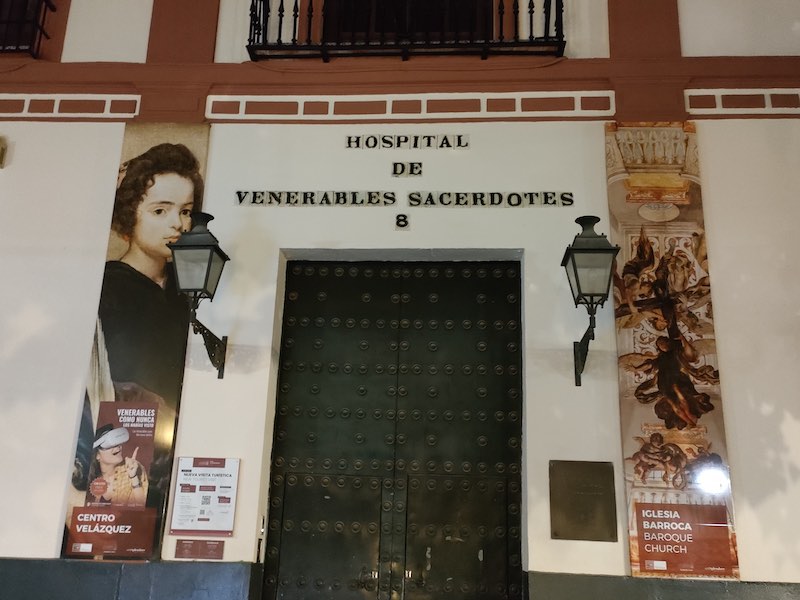
The building itself is a beautiful example of Baroque architecture, with intricate carvings, a grand staircase, and a central courtyard surrounded by arches and columns. The courtyard is particularly noteworthy, with its stunning orange trees and a beautiful fountain.
The Hospital Los Venerables is also home to a museum that houses an impressive collection of paintings from the Baroque period, including works by famous Spanish artists such as Diego Velázquez, Francisco de Zurbarán, and Bartolomé Esteban Murillo. In addition to the paintings, the museum also features a collection of furniture, tapestries, and ceramics from the same period.
Today, the Hospital Los Venerables is a popular destination for art lovers and tourists who are interested in learning about the history and culture of Seville. The building is also frequently used as a venue for cultural events and concerts, making it a vibrant and dynamic part of the city’s cultural scene.
La Casa del Flamenco – Auditorio Alcántara
La Casa del Flamenco is a renowned flamenco venue located in the heart of Seville. It is dedicated to showcasing the art of flamenco, a traditional style of dance, music, and singing that originated in Andalusia, the southern region of Spain.
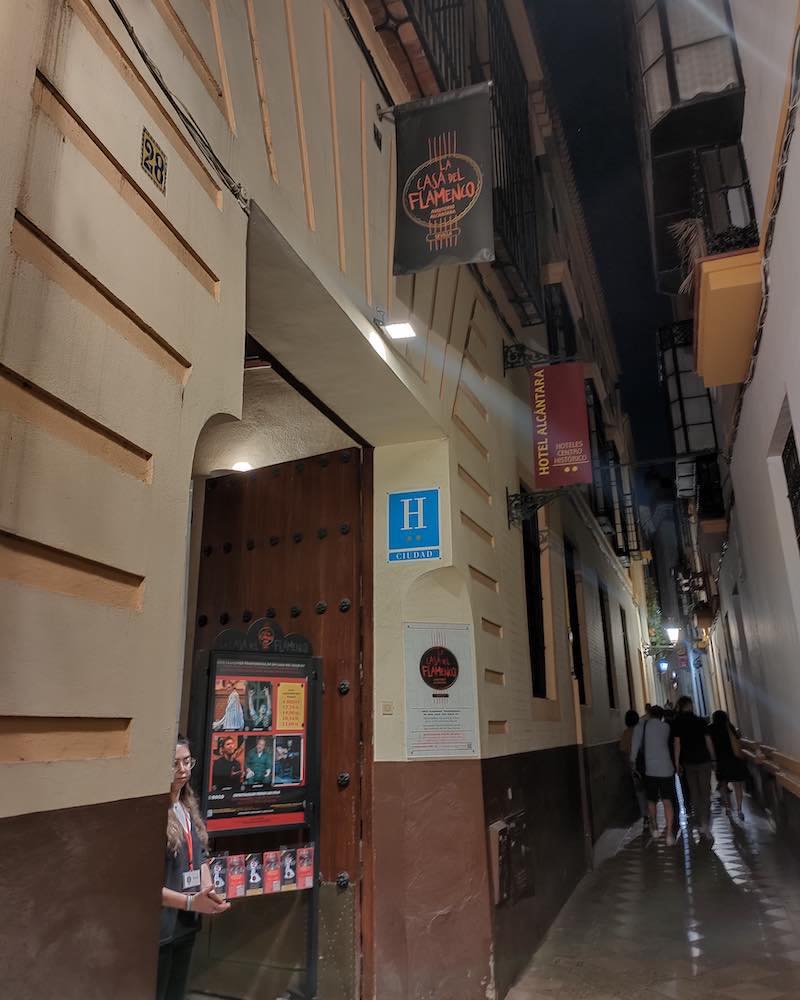
The venue is housed in a historic building that has been restored to preserve its original charm while providing a comfortable and intimate setting for flamenco performances. The space is adorned with traditional Andalusian tiles and features a small stage that allows for an up-close and personal experience for the audience.
At La Casa del Flamenco, you can enjoy live performances by some of the most talented flamenco artists in the country. The shows typically feature a combination of singing, guitar playing, and dancing, and are designed to showcase the passion, energy, and emotion that is inherent in flamenco.
The venue offers performances throughout the year, with shows taking place multiple times per day. Tickets can be purchased in advance or at the door, and the venue also offers special packages that include dinner and a show.
Convento de San José
Convento de San José is a historic convent located in the heart of Santa Cruz. The convent was founded in the 16th century by Saint Teresa of Ávila, a Spanish mystic and writer who was instrumental in the reform of the Carmelite order.
The convent is a beautiful example of Spanish Baroque architecture, with intricate stonework, ornate chapels, and a grand staircase leading up to the main entrance. The interior of the convent is just as impressive, with stunning frescoes, paintings, and sculptures adorning the walls and ceilings.
One of the most famous features of the Convento de San José is the statue of Saint Teresa herself, which is located in the main chapel. The statue is made of ivory and depicts the saint in a state of mystical ecstasy, with her eyes closed and her arms outstretched.
Today, the Convento de San José is still home to a community of nuns who live a contemplative lifestyle and devote themselves to prayer and religious service. The convent also welcomes visitors and offers guided tours of the building and its artwork, providing a fascinating insight into the history and culture of Seville.
Iglesia de Santa Maria
The Church of Iglesia Santa Maria is situated in the heart of the old Jewish quarter and dates back to the 13th century. The church is known for its stunning Gothic-Mudejar architecture, which combines elements of both Gothic and Islamic design. The exterior of the church is decorated with intricate stonework and features a beautiful bell tower, while the interior is equally impressive, with high vaulted ceilings, stained glass windows, and ornate altarpieces.
Where to eat in Santa Cruz
One of the most popular areas for dining in Santa Cruz is around the Plaza de los Venerables, a picturesque square lined with restaurants and outdoor seating. Some recommended options in this area include La Azotea, a cozy tapas bar with a focus on fresh, locally-sourced ingredients, and El Pasaje, a stylish restaurant that serves up modern takes on traditional Andalusian cuisine.
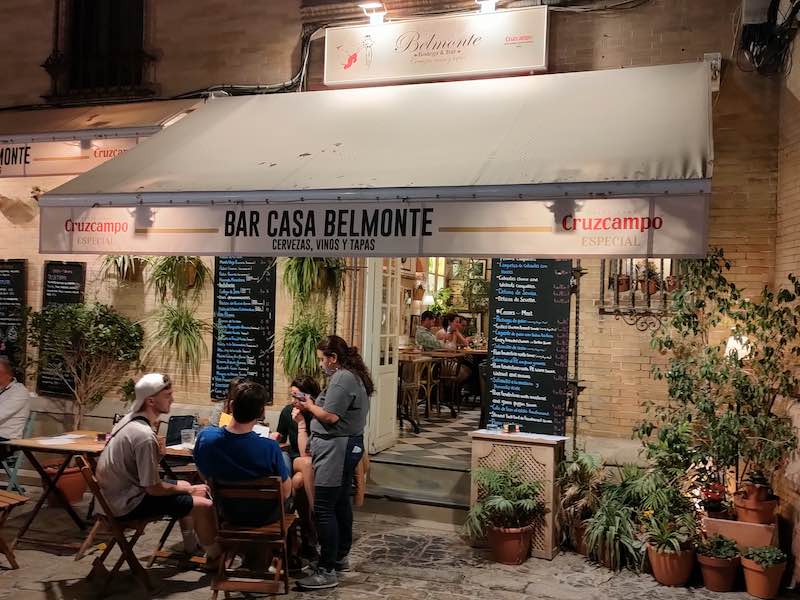
Another great option for dining in Santa Cruz is along Calle Mateos Gago, a lively street that’s home to numerous tapas bars and restaurants. Some recommended options on this street include Bodega Santa Cruz, a traditional tapas bar with a great selection of wines and sherry, and La Bartola, a trendy restaurant that serves up creative takes on classic Andalusian dishes.
If you’re looking for a more upscale dining experience, there are also several great options in Santa Cruz. Restaurante Oriza is a top-rated restaurant that offers a sophisticated menu of Andalusian cuisine, while Restaurante Eslava is known for its creative tapas and modern presentation.
Where to stay in Santa Cruz
There are some great hotels in this area of Seville. It’s such a sociable area that is close to several main attractions (including Seville Cathedral) making it a great place to stay as a tourist. There are many great options for accommodations in Santa Cruz, depending on your preferences and budget.
One of the most popular options for travelers is to stay in a traditional Andalusian-style hotel or boutique guesthouse in the heart of Santa Cruz. These properties typically offer a combination of modern amenities and historic charm, with features like courtyard gardens, rooftop terraces, and traditional tilework.
Some recommended hotels in Santa Cruz include:
- Hotel Casa 1800 Sevilla
- Hotel Las Casas de la Judería
- Hotel Palacio de Villapanés
These properties are all located within walking distance of top attractions like the Alcazar and the Cathedral, as well as numerous restaurants, bars, and shops.
For those on a tighter budget, there are also many affordable hostels and guesthouses in Santa Cruz. These options offer basic accommodations at a lower price point, while still providing easy access to the neighborhood’s top attractions.
Some recommended budget accommodations in Santa Cruz include:
- Hostel One Sevilla Centro
- The Boutike Hostel
- Oasis Backpackers’ Palace Sevilla
These properties offer a range of dormitory and private room options, as well as shared amenities like kitchenettes and common areas.
Overall, Santa Cruz is a great neighborhood to stay in if you’re looking to immerse yourself in the rich history and culture of Seville. With a variety of accommodations to choose from, there’s something for every traveler in this charming and historic neighborhood. You might also like to read this article on where to stay in Seville which discusses the 8 best neighbourhoods in the city (including Santa Cruz).
Further Reading – Andalucia
If you are spending time in the South of Spain, you might also like to read about…
- Visiting the Alhambra Tips
- How to spend one day in Cordoba
- A Guide to the Jewish Quarter in Cordoba
- Cordoba Synagogue – A Hidden Gem
- Visiting Medina Al Zahrat

